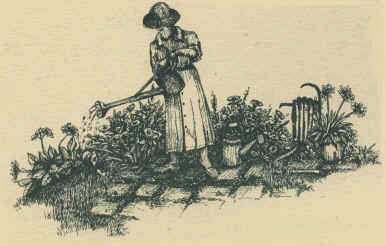|
Water
At The Right Time
-
Drip
systems because they avoid water loss to evaporation and runoff, can
be operated any time.
-
Sprinkler
systems should be run when it's cool - evenings or early morning - to
reduce evaporation. Morning watering also decreases the chance
of mildew. Avoid watering on windy days.
Water
Deeply But Infrequently
-
Clay
soils absorb water slowly but retain it for a long
time. Apply water slowly and infrequently. Consider
adding gypsum (calcium sulfate) to improve drainage and aeration.
-
Sandy
soils absorb water quickly and also drain quickly. Apply
water faster and more often.
-
Loam
soils absorb water well, have, have good drainage, and retain
enough water for plant growth. Apply water at moderate rate
but less often than for sand soil.
-
Allow
water to reach the expected root depth. Use a trowel or probe to
feel for the soil (about eight inches deep for turf grass and two to
three feet for shrubs and trees.) Record the total time required
for water to reach this depth.
-
Apply
only the amount of water the soil can absorb at any one time.
You may need to divide the irrigation time into several shorter
periods or cycles.
-
Before
watering again, allow the soil to dry to a depth of several inches;
time how long that takes. Then, water again for the same amount
of time, watering in cycles if necessary.
-
Get
to know how your plants signal for water. If moisture is low,
grass tends to lie flat under footprints. Some plants lose their
luster and begin to droop before wilting. It's best to water
before the onset of such stress.
Adjust
The Watering Schedule
-
When
the weather changes, adjust your watering schedule (and irrigation
controller if you have one) . On warm or windy days, plants and
soils dry out more quickly. During cooler and wetter months, you
won't need to water as often. Check soil periodically.
-
As
plants grow, adjust your watering schedule. Even low-water use
plants require more water until they become established. Check
these plants periodically and gradually decrease watering frequency,
but continue to water deeply each time
|
|
